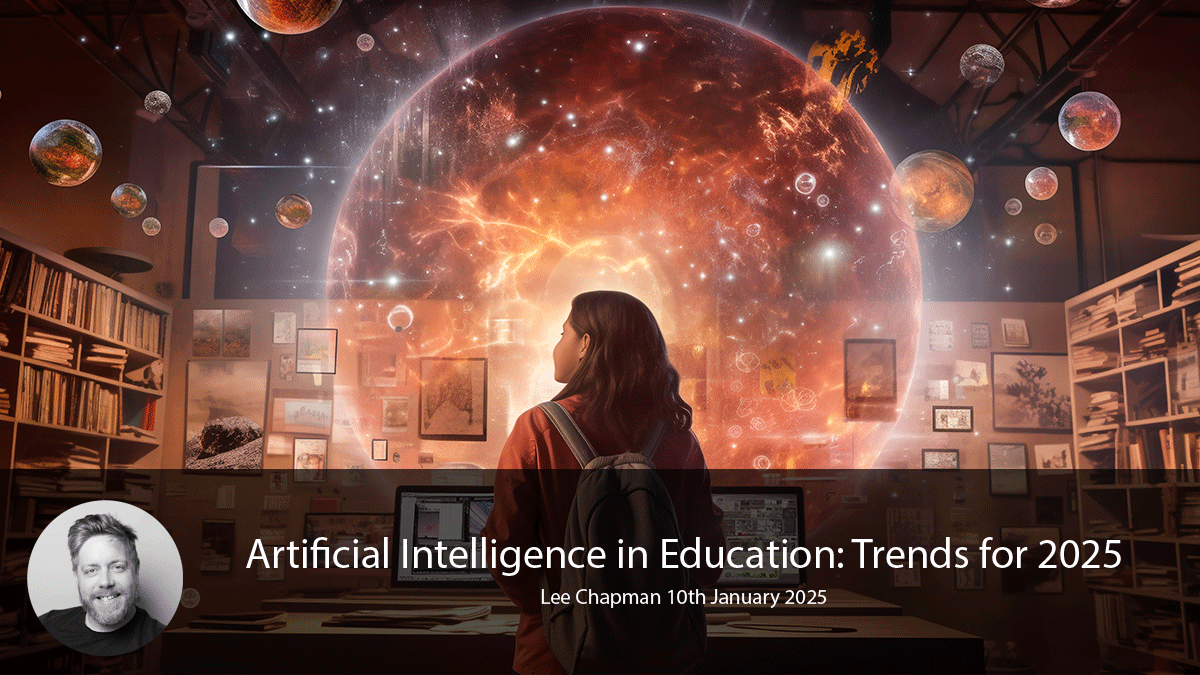Artificial Intelligence in Education: Trends for 2025
Contents

Artificial Intelligence (AI) is revolutionising industries worldwide, and education is no exception. At the university centre where I work in Digital Innovation, I have witnessed firsthand how AI is reshaping teaching and learning. As part of a team driving our AI strategy, I have worked on training staff, developing usage guidance, and exploring cutting-edge tools that hold immense potential for enhancing educational practices. However, this journey hasn't been without challenges. Supporting students and addressing academic misconduct, particularly when AI tools are misused, have been significant learning experiences.
The rapid evolution of AI-powered tools has introduced new opportunities and complexities. For instance, tools like Grammarly can offer instant feedback on student writing, streamlining assessment processes. Yet, its generative AI features sometimes produce overly polished outputs that raise academic integrity concerns. Students that have used Grammarly tent to have a higher AI-Generated score which could lead to academic misconduct. As we approach 2025, key AI-driven trends such as personalised learning paths, intelligent tutoring systems, and enhanced accessibility promise to further transform the educational landscape.
It is vital to remember that AI-generated content should always be reviewed by educators, who remain the true experts in their fields. By combining AI's insights with their own expertise, educators can co-create innovative, pedagogically sound content and learning plans. This collaborative approach enhances creativity, efficiency, and quality, ultimately leading to better teaching and learning outcomes.
1. Personalised Learning Paths

Description: This image conveys how technology can tailor educational paths to individual needs, ensuring students navigate their learning journeys effectively.
One of the most exciting developments I've observed is the ability of AI to create customised learning experiences. I've worked closely with educators to implement tools that adapt content based on individual student needs. By analysing a student's learning style, strengths, and areas for improvement, these platforms ensure students stay engaged and make meaningful progress. Seeing students thrive under this personalised approach has been incredibly rewarding, as it shifts education away from a one-size-fits-all model.
For instance, platforms like Knewton and Smart Sparrow are excellent examples of how AI tailors learning experiences. A colleague recently shared how an AI platform adapted their teaching resources in minutes rather than hours. They were able to produce additional tasks and materials tailored for different learning levels—something they wouldn't typically have the time for. This included tasks specifically designed to challenge high-achieving students. The result? Students were able to tackle more advanced concepts with confidence, deepening their understanding and engagement. Educators can explore these tools to understand the possibilities of adaptive learning.
Additionally, educators can use AI tools such as ChatGPT to create personalised learning plans for their students. For example, a teacher might input details about a student’s current strengths, challenges, and learning goals into ChatGPT to generate a tailored plan of activities, resources, and feedback. For instance, a teacher could use the following prompt to get started:
These tools can even provide examples of differentiated instruction or strategies to support diverse learning needs.
2. Intelligent Tutoring Systems

Description: The image captures a learner engaging with AI-enhanced tutoring tools, showcasing how smart technologies personalize the educational experience.
In my role, I’ve explored how AI can support personalised tutoring, not by relying solely on traditional tutoring systems but by crafting effective prompts and piloting innovative tools. For example, I worked on a personalised chatbot trained with specific information to address students' unique questions and needs, which significantly enhanced engagement. Additionally, I provided training on NotebookLM, a tool students can use to collate module information and interact with it as a personal tutor. These approaches empower students to tackle challenges independently and offer them a tailored learning experience that fosters confidence and retention.
If you are interested in paid services using this technology, have a look at platforms like Socratic by Google or Carnegie Learning, which exemplify the benefits of AI tutors.
Educators and learners can also use free AI tools to achieve similar outcomes, such as NotebookLM and ChatGPT. NotebookLM, for example, enables students to curate their own interactive podcasts based on module content, enhancing engagement after each lesson. Alternatively, ChatGPT can act as a virtual tutor to provide explanations, clarify doubts, and guide learners through challenging concepts. To make the most of this, educators can craft detailed prompts tailored to their subject matter and student needs.
3. Automated Administrative Tasks

Description: Highlighting the integration of robotics and AI in routine office tasks, this image depicts a collaborative workspace where AI complements human effort to enhance productivity.
One area where AI has had a direct impact on staff workload is in automating administrative tasks. Tasks such as offering instant formative feedback, planning lessons, creating resources, and tracking attendance can now be streamlined with AI tools. This has allowed educators to focus more on teaching and supporting students, enhancing their overall effectiveness. I've worked on integrating some of these systems, and the feedback from staff has been overwhelmingly positive.
Platforms such as Turnitin not only check for plagiarism but also highlight areas for improvement in student's work, providing educators with actionable insights.
For lesson planning, AI-driven platforms like LessonUp can suggest engaging activities and structure complete lesson plans based on input topics, significantly reducing preparation time while maintaining quality. Similarly, Planboard offers streamlined lesson organisation, allowing educators to manage their curriculum more efficiently.
Additionally, tools like Microsoft Power Automate can help educators automate repetitive tasks such as sending reminders for assignment deadlines or notifying students of schedule changes. For managing emails, setting up automation rules in Outlook can sort messages into specific folders, block junk mail, or even send automated responses, freeing up valuable time. When writing reports or analysing student data, tools like Excel with Power Query or Power BI can generate detailed insights while saving hours of manual effort. However, educators should exercise caution when using these tools, ensuring sensitive data is handled responsibly and not shared with AI systems that lack adequate data privacy measures.
By leveraging these AI systems, educators can focus their energy on the core aspects of teaching and student engagement, making their roles more impactful and less burdensome.
4. Enhanced Accessibility

Description: This image emphasizes the importance of accessibility tools, like real-time captions, in ensuring inclusive learning environments for students with diverse needs.
As someone passionate about inclusion, I'm particularly proud of how AI is improving accessibility in education. For example, our senior lecturers piloted an initiative that introduced Otter.ai in lectures to provide real-time transcription. Students with hearing impairments reported feeling more included and able to fully engage in discussions, while other students found the detailed transcriptions invaluable for reviewing lecture content. This could ease the pressure of educators by ensuring every student had access to accurate notes, creating a more equitable and efficient learning environment. These technologies ensure that learning materials are accessible to everyone, fostering a truly inclusive environment. Witnessing the impact of these tools on students' confidence and participation has been one of the most fulfilling aspects of my work.
We leverage built-in AI features in Blackboard to convert resources into multiple accessible formats, such as audio, braille-ready files, or structured PDFs. Google's latest accessibility improvements also provide additional options, such as live captioning and real-time translations, ensuring inclusivity for students with diverse needs. Microsoft's accessibility advancements, including real-time transcription through Microsoft Teams and Immersive Reader, have been transformative. In our institution, we've used Immersive Reader to assist students with dyslexia, allowing them to engage with course material more effectively. These tools empower educators to make materials available in formats that meet the unique requirements of all learners, fostering an equitable and inclusive learning environment.
5. Data-Driven Insights

Description: This image emphasizes the power of data visualization and analytics in driving informed decision-making across various industries.
AI's ability to analyse educational data has been transformative. At our institution, we've implemented systems that provide actionable insights into student performance and engagement. This data allows educators to identify trends, tailor interventions, and improve outcomes. Personally, I've found that these insights often uncover patterns we wouldn't have noticed otherwise, enabling more proactive support for students.
For educators seeking free options, Google Sheets with add-ons like the "Explore" feature can help generate quick visualisations and insights from data. For more detailed analyses, open-source platforms such as KNIME provide powerful tools for educators to explore trends and make data-driven decisions.
For those interested, tools like Tableau and Power BI are excellent for visualising and leveraging educational data effectively.
6. Virtual Learning Environments

Description: This image highlights the use of virtual reality in education, creating immersive learning environments that bring subjects to life.
The rise of virtual learning environments has been another game-changer. I've been involved in integrating AI into these platforms to create interactive and immersive experiences. Whether it's adaptive simulations or virtual tutors, these tools are expanding learning opportunities beyond the traditional classroom. The flexibility and engagement these environments offer are especially beneficial for students who thrive in non-traditional settings.
Free platforms like Google Classroom can be enhanced with plugins and tools to incorporate AI-driven features, such as personalised assignments or interactive quizzes. Additionally, educators can use H5P to create engaging and interactive content within learning environments at no cost.
Platforms like Moodle and Canvas demonstrate how AI can enhance virtual learning environments to offer more personalised and engaging experiences.
7. Ethical Considerations and Challenges

Description: This visual represents the critical role of ethics in AI, illustrating the balance between technological advancement and moral responsibility.
Of course, no discussion about AI in education would be complete without addressing its challenges. In my work, I've encountered concerns about data privacy and algorithmic bias, as well as instances where students misuse AI tools. These experiences have taught me the importance of clear guidelines and ethical considerations. At our institution, we've developed comprehensive AI usage policies to address these issues and ensure that technology is a force for good in education.
Educators can explore resources like the free version of Ethics Canvas to draft ethical guidelines and evaluate potential risks of AI in their classrooms. Moreover, incorporating open discussions about the ethical use of AI in classrooms fosters awareness and accountability among students.
Why not explore resources like EU AI Ethics Guidelines for a deeper understanding of ethical AI use.
Conclusion
AI is poised to significantly transform education by 2025, and I'm proud to be part of this journey. The opportunities to enhance teaching and learning are immense, but so are the responsibilities. By embracing these trends thoughtfully and addressing the challenges head-on, we can harness AI's full potential to create a more inclusive, engaging, and effective educational landscape.
